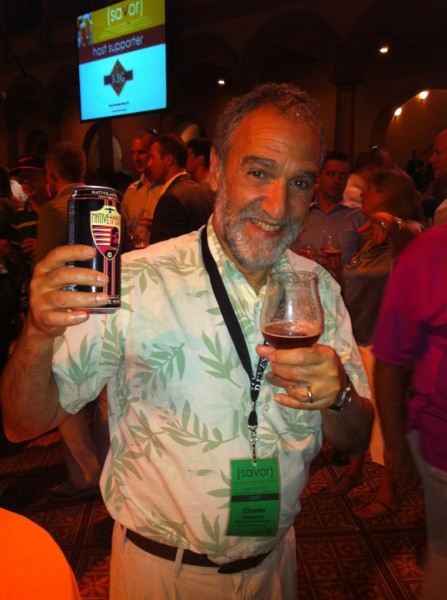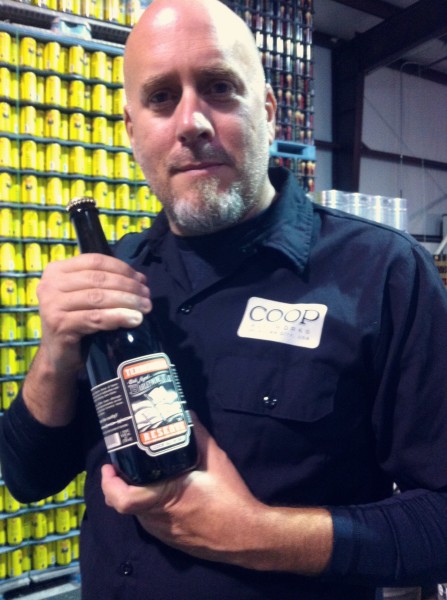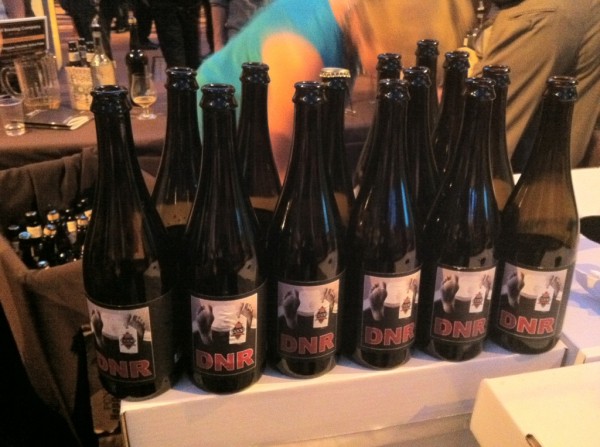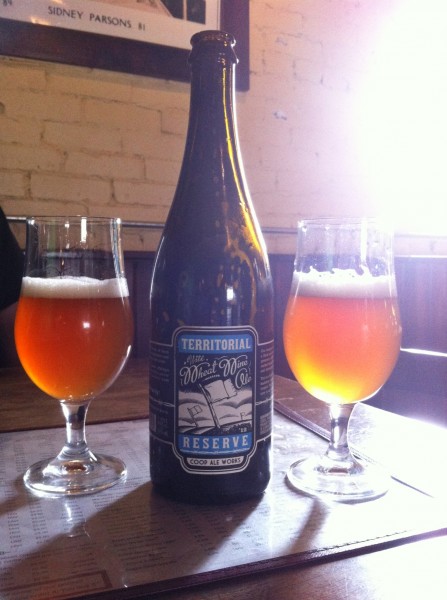This week we exclusively focus on COOP Ale Works. Exciting changes are coming for this three-and-half year-old Oklahoma City-based brewery. First, co-owner JD Merryweather said their brewery had a strong showing at Savor, a craft beer and food festival. At this event COOP’s DNR, a Belgium-Style Golden Ale, had been paired with roast beet and chevre tartlet, with a sherry gastrique, while their Native Amber ale had been paired with salt cod fritters, and a malt vinegar gastrique.
Second, COOP plans to take their Sanchez Pro Am (Professional Amateur) beer to the Great American Beer Festival, which Stefan Morris, new okc.net beer reviewer, informs me is “the-e-e-e-e†beer festival to attend in all of the U.S. We went in search of the Coop’s Pro Am, and discovered you can find it at Tapwerks.

Charlie Papazian, pictured enjoying COOP’s Native Amber at the Savor Craft Beer event, is the author of The Complete Joy of Homebrewing, founder of the Great American Beer festival, the American Homebrewers Association and the Association of Brewers.
Third, COOP has a Territorial Reserve Barley Wine shipping out the week of September 1st. It will be on tap at select locations and available by the bottle at a few spirit shops. The Territorial Reserve Barley Wine is oak-aged in Jack Daniels barrels. These are the same barrels that previously held COOP’s Imperial Oak-Aged Stout. Merryweather describes the barley wine as having dried fruits, spice, a hint of caramel, and a sour finish. He expects the alcohol content to be somewhere between 10-12%. He suggested the barley wine would be best paired with braised bison ribs or saffron and scallops. This is a limited run with only 1,500 bottles, each hand labeled, so keep your eyes open for it when it hits the shelves. It is expected to retail anywhere from $16-$20 a bottle.

JD Merryweather teases us with a bottle of the Territorial Reserve Barley Wine. I already know I’m going to buy a few bottles to both enjoy and squirrel away. Also, ignore the blurry iPhone photo, the DSLR is in the shop for repairs.
You would think COOP couldn’t possibly have any more news to share, but you would be wrong. COOP has been doing incredibly well these past three years, so much so that the growing demand for their beer will allow them to sell their current brewery within the next few months and move into another location. The new brewery will house a 30-barrel system and will be 16,500 sq ft. But until then, you can still tour their current location, 1124 NW 51st Street, on the first and third Saturdays of the month at 2:00 p.m. Visit their website or call 405-842-2667 for more information.
Of all the Oklahoma breweries I’ve sampled, I still maintain that COOP is my favorite hands down. I know they don’t stick to the “traditional” style guidelines, but they are consistent from batch to batch, and they don’t shy away from huge flavors. They’ll be at the Choctaw Oktoberfest with the following beers: DNR, Zeppelin, and Oktoberfest. It is worth noting that COOP also offers experimental beers or beers in development at some of the festivals they attend, a fact that I had not known but wish I had. Merryweather said one such rare offering had been a beer that featured orange blossoms and blood oranges. In addition to participating in beer festivals, both local and across the nation, they also sponsor teams and charity events.
This week we review: DNR, Zepplin, Oktoberfest, Pro AM, and the Territorial Reserve Wild Wheat Wine that we found at TapWerks.
DNR
Style: Belgium-Style Golden Ale
ABV: 10%
Helen:
I don’t have Stefan’s advanced palate, which he calls “down to earth,†but as far as what I detect in this beer: I get a hint of raisins, cinnamon, and a little bit of apricot. It’s moderately sweet and fruity at the forward, gets a bit sour at its peak, and finishes with a bitterness that has a hint of caramel-laced throughout. The DNR also has a deep amber color. This has to be one of my favorites when it comes to COOP’s line of beers. I’ve had it on draft and in the bottle, just a solid beer all-around. With a medley of flavors that dances across the palette and 10% ABV, DNR is a good choice any day of the week. But be forewarned, it will get you “business drunk†if you have it while you’re out at lunch.
Stefan:
It may come as a surprise to some that DNR did not always fit my taste, as big Belgian beers were my gateway into craft brew. While I know my taste has improved over the years, I have a sneaking suspicion that DNR has improved as well. Regardless whoever or whatever changed in this relationship doesn’t matter. It does matter that DNR is now the Oklahoman beer that I share with people when they think that this state does not know how to produce a big, full flavored, complex, mouth, and assumption wrecking bomb of a beer.
I most recently had DNR served in a tulip glass from the tap at Republic. The beer appeared dark amber, and very clear. There was no head to speak of, but rather a thin ring of bubbles around the edge of the glass.
DNR smells of raisins, vanilla, figs, and sweetness. The smells and taste match well with the first sip exploding with caramel, vanilla, raisins, and figs. Floral and spicy hop notes follow before some serious bittering kicks in with just a touch of sourness. The taste tapers out with sweet caramel and a boozy warming finish that is reminiscent of a premium bourbon, but toned down several notches. Every sip lays it on thick and leaves your mouth warmed, and slicked with delicious if not slightly sticky goodness. Carbonation was minimal.
Overall, if you like big beers, complex flavors, or just getting thoroughly inebriated on local 10% ABV beer while looking like a boss, then order this beer. DNR has something for everyone, in spades. Just make sure to designate a driver or you may earn yourself a toe tag to match the guy on the label, who I can only assume passed with a smile on his face.

Empty bottles of DNR at the Savor Craft Beer and Food event.
Zeppelin
Style: Hefeweizen
ABV: 5.6%
Helen:
I like hefeweizens. It’s the style of beer I choose when I don’t know what I want. But the Zeppelin, which is COOP’s interpretation on the style, is a little hoppier than I would prefer. To put it in perspective, it has a 18 IBU (International Bitterness Units), the typical guideline for hefes is 8-15 IBUs. I still get hints of banana and clove, but the bitter citrusy finish definitely overpowers those other flavors for me. It’s not bad, but I would pick Ayinger’s Brau Weiss or Franziskaner Hefeweizen first as that’s how my tastes skew when it comes to hefes. All said, I’m willing to drink a Zeppelin again.
Stefan:
Like Helen, I’ve always been a fan of this style, so much so that I usually have five gallons of my own recipe in my kegerator. I sampled COOP’s Zeppelin on tap at Republic.  The pour was a dark yellow with mild haziness. There was virtually no head, and no lacing, which was surprising for a hefeweizen, and may be more indicative of Republic’s taps and not the beer in general.
The smell delivers everything I want in a hefeweizen. Bananas and bubblegum odors are big and roll off the nose in droves. However, the taste is a far cry from the smell. A hint of bananas may be glimpsed before being burried by overly wrought citrus and hop bitterness. The stronger flavors eventually taper off allowing some of the sweet malt backbone and clove flavors to assert themselves in a fight over what flavors will dominate the final taste. Unfortunately, in this case, the hops win. The body is a little thin, and the carbonation felt more on par with an American ale than a hefeweizen.
Overall the Zeppelin delivers a fairly original take on the hefeweizen experience that is consistent with COOP’s somewhat aggressive hopping and experimental attitudes. However, I feel like they were a little hasty to throw away the tried and true formula of a hefeweizen, while not establishing their own niche in the style. While I certainly wouldn’t turn this beer down on a hot summer day, I also wouldn’t seek it out when many suitable alternatives exist.
Oktoberfest
Style: Marzen
ABV: 5.5%
Helen:
The Oktoberfest is COOP’s interpretation on the marzen style of beer, although it is brewed in the true marzen fashion, which means it is brewed in the spring and condition in the coming months so that it will be ready by the fall. My tasting notes read that it’s a “little citrusy with the hops.” I’ve come to the realization that COOP really loves hopping things up, but that said, there is some sweetness on this one that comes from the style of malt that COOP uses. Would I have this again? Yes. In fact, I think I’m going to give it a second go at the Oktoberfest in Choctaw this weekend.
Stefan:
I can really get behind a good marzen this time of year. Perhaps it is my fondness for bread, and the kind of German ingenuity that decided to make liquid bread-esque session lagers which pair well with more traditional solid bread, and of course tube shaped meat products. How could one possibly go wrong?
COOP’s entry into this malty tradition poured a medium amber with slight cloudiness, and generous near white foam. The nose promised rich bready malts with some sweetness and just a touch of sulfur.
In this case the first sniff was deceiving. The beer took a more hop-forward approach, rather than the traditional malt driven profile that defines the style. One might say that it is overly bittered, as the toasted malt notes are somewhat muddled. The initial marzen sweetness is unaffected, and the beer ends on a clean and refreshing note. The slight sulfur smell in the nose is not present in the taste. The beer has a medium body, and a moderate level of carbonation. The combination of flavors and mouth feel promises that many liters could be comfortably consumed.
Overall my preference is for more traditional approach on this style. While I recognize the take as valid, and found the beer refreshing and enjoyable, the initial taste was a bit off-putting. Once I got over my expectations, and remembered that COOP likes to push the boundaries on style I was able to enjoy this beer. I’ll see how it pairs with pretzels and wurst at the upcoming celebration in Choctaw, and then put it to the real test; to see if it can convince me to do the chicken dance on top of a picnic table with total strangers. I have a feeling that it will pass that test with flying colors, and cement its already solid showing.

This is a very fruit forward wheat wine with a strong sour finish. Quantities are limited. I believe this was bottle 1084 of 1492. Incidentally the latter being the same year Columbus sailed the ocean blue, and it was the same year the Ottoman Empire fell. Beer and history: they pair well together.
Wild Wheat Wine Ale
Style: Wheat Wine
ABV: 11%
Helen:
After hearing about the Territorial Barley Wine, we decided to find and then try another one of COOP’s Territorial Reserves before it was gone. The Wild Wheat Wine is dark golden orange, cloudy, and has a nice foamy head. My previous experience with wheat wine was trying Boulevard’s Harvest Dance earlier this summer; it’s in their Smoke Stack series. I found COOP’s Wild Wheat Wine by comparison to be more flavorful, which might have something to do with the wild yeast used, local alfalfa honey, and additions of malted and unmalted wheat. Honestly, it reminds me of apricot jam. It’s not overly sweet at all, but it is definitely fruity – apricots, a note of apple, possibly a hint of pear – and the carbonation on this one makes it tingle on the tongue. I know the wild yeast may give it a “funk,” or a sour flavor that is considered “off,” but truth be told I liked it. If I happen to find it on a shelf the next time I’m at the liquor store, I’ll probably pick up a bottle to age and see how that turns out too.
Stefan:
Initially, I wasn’t sure if I was getting into a wheat Wine, or a wild Ale, but I knew that by the end of the bottle I would find out and likely be fantastically drunk. To keep it simple for the uninitiated, wheat wines are big alcoholic American strong ales that have a lot in common with barley wines, but with lots wheat malt. Wild ales are a fair bit more interesting as they incorporate the use of non-standard wild yeasts or additions of bacteria whose presence would normally constitute the spoiling of a beer, but in careful application can introduce new and interesting flavors. Some people still feel that these flavors spoil the beer, but we of course know better.
The Wild Wheat Wine Ale was served from an individually numbered 22.5 oz bottle, number 1084 of 1492, in a tulip glass. The coloration was medium orange with plenty of wheat haze and a solid inch of white foam which was present until nearly the last drop. Lacing was minimal.

Stefan says: “Apricots, apricots, apricots!”
The smell was dominated by a promising acidic sour funk, and complemented by apricots and a touch of wheat. Getting down to the taste, initially I am bombarded with apricots, apricots, apricots! This is not the first time I’ve picked up apricots in a COOP beer tasting, but it is certainly the most pronounced. Not to be left out pear makes an appearance as well. A wheat maltiness comes through in the middle that is more normal for a wheat wine, followed by strong sour funk that melds seamlessly into an equal part dry and sour finish. The funk is hard to nail down from a flavor standpoint, but it certainly validates the use of the word wild in the name of this beer. The carbonation was in the medium to high range, which paired well with the flavor, and helped the sour notes dance a bit more on the tongue. The high alcohol content was not hidden, so much as incorporated into the sourness, leaving an utterly quaffable 11% ABV beer, which is no small feat.
From an overall standpoint I really enjoyed the Territorial Reserve Wild Wheat Wine Ale. It has a crazy anything goes sensibility to it that may not please the most ardent fans of either of the two originating styles, but will certainly light up the taste buds of any adventurous beer non-conformist. To answer my original musing, it is not so much a wheat wine, or wild ale, but rather its own style which should be enjoyed on its own merits. These bottles are already in dwindling supply, so make sure to snag one before they run out.
COOP Pro-Am Belgian Pale Ale
Style: Belgian Pale Ale (BPA)
Stefan:
COOP’s Belgian Pale Ale, or BPA, is the work of Bruce Sanchez (who you can follow on Twitter @BrewceSanchez) and head brewer Blake Jarolim (@fermentus). I had a chance to enjoy this fine beverage at TapWerks. The beer was listed as Sanchez Pro-Am BPA, on the menu and will be COOP’s entry into 2012’s Great American Beer Festival. As mentioned earlier, the GABF is a major festival and competition for craft brew.
The beer was served on tap in a pint glass. The coloration was golden yellow with a slight haze. A half inch of white head was present on the pour, but it dissipated rather quickly, leaving a moderate amount of lacing across the glass.
The smell was dominated by two notes, namely a slight honey sweetness, and a tinge of bitter orange. The beer has an initial honey sweetness and biscuit like flavor, followed by solid Belgian spice notes. The flavor progressed to strong hop and orange rind like bitterness. The sweetness was lost to a degree with further tasting, leaving the spiciness and bitter oranges as the key flavors. The mouth feel could be described as soft. Carbonation levels are somewhat lower than most American ales which is appropriate for the style, and works well with the medium body. While the beer leaves a residual stickiness on the tongue, the lingering bitterness helps to clear the pallet much like a drier beer does with the alcohol content.
Overall the COOP Sanchez Pro-Am BPA is a solid drink that any beer loving Oklahoman should be proud to have representing the state in the Great American Beer Festival. This beer manages to be refreshing, while still presenting a bold complement of flavors. It may be a bit much for the style, but COOP doesn’t really know what a bit much is, and I believe that is a good for us, and hopefully good for the judges as well.
The 3×3 Challenge:
We’ve decided to do a snapshot of our tastes this week. The question we pose is this: if you had to be stranded on a deserted island for 3 months, which 3 beers would you take with you?
J.D. Merryweather’s picks:
1. Coop Ale Works F5 IPA
2. New Glarus Belgium Red
3. Cuvee de Jacobins Rouge
Helen Grant’s Picks:
1. Ayinger Bräu Weisse
2. Chimay Tripel (White)
3. Schneider Aventinus Weizen-Eisbock
Stefan Morris’ Picks:
1. Dogfish Head 90 Minute IPA
2. Ayinger Celebrator Doppelbock
3. Great Divide Oak Aged Yeti
Extra Reading:
1. Savor – American Craft Beer and Food event.
2. Great American Beer Festival. (I’m told getting tickets to this event was not unlike purchasing tickets for the Jack White’s concert in Tulsa this past March, as they are gone within the first few minutes of becoming available.)
3. Choctaw Oktoberfest.
The un-resuscitated “guy” on DNR’s label is actually a girl! Wish I could remember her name, to give her due where due is dead.